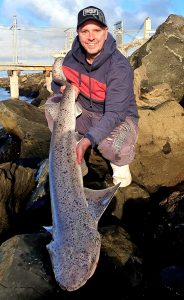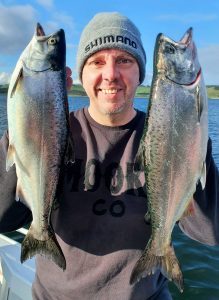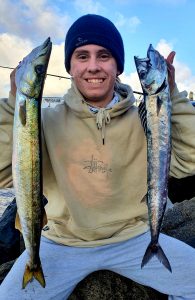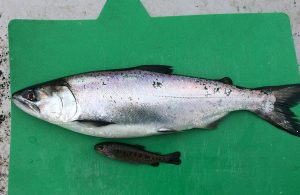
Ash Rawlings with the seven-gilled shark he caught from the Lee Breakwater at Portland.

Ash Rawlings with a sample of the chinook salmon that he and wife Trish caught from Lake Bullen Merri.
Down Portland way, Ash Rawlings reports that vast schools of bait fish have been pushed inshore by predatory barracouta and snook, their presence being betrayed by birds circling overhead.
He, and son Cam of Portland Bait and Tackle, were quick to take advantage, catching them from the Lee Breakwater, both for the table and to go into the freezer for future gummy shark bait.
Naturally enough, with other species on offer from the breakwater like snapper, they put portions of their barracouta fillets out for bait, and on one occasion, caught a seven-gilled shark of about 25 kg that was released to swim away unharmed.
Ash, and wife Trish, also fished from their boat on Camperdown’s Lake Bullen Merri where their berley trail soon had chinook salmon on the go, catching them at will using pilchard fillets for bait.
Hoping for more variety, and a change of pace, they set about trolling lures, but once again, chinook salmon – mostly around the 700 gram mark – were all that was on offer.

Cam Rawlings with a sample of the barracouta and snook currently on offer from the Lee Breakwater at Portland.
Corio Bay/Bellarine Peninsula
With yesterday’s low tide at first light, Jason Treloar – who’d caught a nice snapper nearby the previous week – fished land-based from the North Shore rocks below the Esplanade where, casting a bibbed lure paid off with the capture of a good size snook.
Andrew Johnson and wife Jenny were at crossroads as to whether they would try for whiting or snapper, given that a few of the latter have been taken lately, and eventually – given the stirred up conditions on the bay – snapper were to be their target.
The usual signature of small pinkies wasn’t hard to pick up around the channel junction off Curlewis, so they took a run to the north, soon picking up more promising readings, and it wasn’t long before one of their baits, a squid head, was taken in typical snapper fashion.
Unfortunately though, the hook pulled free, and passing that information onto his oft-time companion, Dennis O’Brien – who was just heading out at the time – going for whiting seemed a more realistic proposition.
And, his decision to anchor up on one of their favourite whiting grounds off Curlewis paid off, for he picked up fifteen good size whiting before the bite shut down.
With a break in the weather early last week, Andrew Phillips and Mark Sesar headed out off Queenscliff, hopeful of catching some whiting offshore off the mouth of Swan Bay.
Initially it was lean pickings, and like a good many others of late, found them scarce. But undeterred, they kept prospecting here and there until late afternoon, when – after anchoring up just north of Coles Beacon – their luck changed for the better.
And, by the time the incoming tide had slackened toward nightfall, they had their respective bags of whiting, the biggest measuring 42 cm.

As unbelievable as it appears, these fish are of approximately the same age. The 700 gram chinook salmon was released as a fingerling while the 20 gram rainbow trout was released as a yearling, it’s extended time in the hatchery depriving it of its most critical period of growth, and adaption to its eventual environment (Picture Garry Ridgeway).
Freshwater
Kevin Wild of the Maryborough Angling Club and wife Amber fished Lake Tullaroop last week, but it was lean pickings there with only three redfin to show for their efforts.
Undeterred, Kevin was out again a day or so later with Don Rayner; and although their lure-trolling exercise was for naught, switching to the use of micro-jigs, which they dropped over any clusters of fish that showed up on the sounder, saved the day as it turned out, for they caught eight good size redfin doing that.
Chinook salmon fishery
Renowned angler, Garry Ridgeway’s response to last week’s question as to why chinook salmon no longer reach the comparatively large sizes that they have been recorded as reaching in the past, is worthy of consideration.
He makes the point that their greatest period of growth, and most important adaptation to their environment, occurs immediately following their emergence as hatchlings.
The longer they are deprived of their introduction to the wild, the more limited their eventual size will be. And, he says, this is demonstrated by the reduction in the limited growth of fish that have been retained in the hatchery for extended periods.
While being sheltered from predation in the hatchery, and fed on processed food – sometimes for the first year of their life – satisfies some management criteria, he says it severely limits the size to which these fish will eventually grow.
